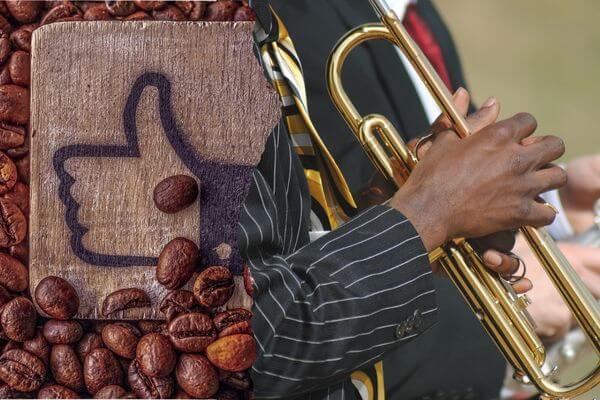Coffee, the beloved beverage that fuels our mornings and provides comfort throughout the day, has also found its way into the realm of pop culture. It’s no secret that coffee holds a special place in our hearts and our daily routines, but its impact reaches far beyond our personal cups.
From iconic movie scenes to lyrical references in songs, coffee has become a symbol of energy, creativity, and connection in the entertainment industry. In this article, we will embark on a journey through the captivating relationship between coffee and pop culture, exploring its presence in films, television shows, music, fashion, art, and more.
Get ready to discover how coffee has infiltrated the realms of entertainment, leaving an indelible mark on our cultural experiences.
The silver screen has long been a canvas for coffee’s cinematic journey. It has graced the hands of detectives solving crimes, writers seeking inspiration, and friends bonding over heart-to-heart conversations.
Think of the iconic café scene from “Casablanca,” where Rick and Ilsa share a bittersweet moment over cups of coffee, or the memorable coffee shop encounters in “Coffee and Cigarettes,” where conversations flow as freely as the brewed beverage itself.
These scenes not only showcase coffee as a prop but also highlight its ability to facilitate emotional connections and heighten the atmosphere of a scene.
Coffeehouses, with their warm and inviting ambiance, have become synonymous with meeting places and a backdrop for storytelling in both fictional and real-world narratives. They serve as the perfect setting for characters to gather, share secrets, and embark on adventures.
In popular TV shows like “Friends” and “Gilmore Girls,” coffee shops like Central Perk and Luke’s Diner have become beloved landmarks, fostering a sense of community and familiarity for viewers.
These fictional coffeehouses have transcended the screen, inspiring real-life establishments that aim to recreate the cozy atmosphere and sense of camaraderie portrayed in their on-screen counterparts.
The influence of coffee extends beyond its visual representation and into the realm of music. Countless songs have paid homage to the beverage that helps us wake up and start our day. Whether it’s the classic crooning of Frank Sinatra in “The Coffee Song” or the energetic anthem of “Black Coffee in Bed” by Squeeze, coffee has permeated the lyrics of various genres.
These musical tributes not only reflect the widespread love for coffee but also serve as a relatable thread that connects listeners through their shared appreciation for this daily ritual.
Coffee and comedy go hand in hand, providing endless comedic material for entertainers. The spillage of hot coffee, the exaggerated reaction to caffeine jitters, or the reliance on coffee to stay awake during mundane tasks have all become comedic tropes.
Comedians skillfully incorporate these coffee-related scenarios into their acts, eliciting laughter from audiences who can relate to the humorous side effects of coffee consumption.
Coffee’s influence has even spilled over into the realm of fashion, where it has become a trendy statement. From quirky t-shirts adorned with coffee-themed slogans to accessories shaped like coffee beans or cups, coffee has carved a niche within the fashion industry.
Coffee-themed merchandise not only showcases our love for the beverage but also allows us to express our identity as coffee enthusiasts.
In the world of celebrity, coffee has transcended its role as a mere beverage to become a lifestyle statement. Celebrities have embraced the coffee culture, sharing their favorite brews and creating collaborations with coffee brands.
These partnerships have given rise to signature blends, limited-edition coffee products, and even celebrity-owned coffee shops. By aligning themselves with coffee, celebrities tap into the cultural significance of the beverage and offer fans a glimpse into their personal preferences.
The influence of coffee extends beyond visual and auditory mediums, reaching into the world of art. Coffee has been used as a medium itself, with artists creating intricate designs by manipulating coffee stains and using coffee as a paint or dye.
These coffee-inspired artworks not only showcase the versatility of the beverage but also provide a unique perspective on its cultural significance.
Coffee’s impact on pop culture is undeniable, permeating various facets of the entertainment industry. Its presence in films, music, fashion, art, and celebrity culture speaks to its universal appeal and its ability to create connections and inspire creativity.
As you navigate the realms of pop culture, keep an eye out for the subtle and not-so-subtle references to coffee, and appreciate the influence this beloved beverage has on shaping our cultural experiences.
Lights, Camera, Coffee: Coffee’s Cinematic Journey
Coffee has played a captivating role in the world of cinema, gracing the silver screen in memorable and iconic ways. From the alluring aroma that fills the air to the intimate conversations that unfold over a cup of joe, coffee has become a vital element in storytelling, adding depth and authenticity to cinematic narratives.
In this section, we will explore the captivating journey of coffee in the realm of movies and delve into its significance as a symbol of connection, introspection, and emotional resonance.
Coffee’s presence in films goes beyond its role as a mere beverage. It has become a visual and sensory cue that adds texture and atmosphere to scenes. The act of brewing coffee, the sound of a coffee grinder, or the steam rising from a freshly poured cup all contribute to the sensory experience that draws viewers into the film’s world.
These cinematic moments serve as a gateway to the characters’ emotions and inner worlds, providing insights into their state of mind and driving the plot forward.
Coffee has often been used as a catalyst for meaningful interactions and conversations in movies. It has the power to break down barriers, bringing people together and fostering connections.
Think of the coffee shop encounters in “Before Sunrise,” where two strangers engage in deep philosophical discussions that leave a lasting impact.Or consider the coffee-fueled dialogue between mentor and mentee in “Good Will Hunting,” where wisdom is shared over steaming cups of coffee.
These scenes highlight the role of coffee as a facilitator of authentic human connections, transcending social boundaries and bringing characters closer together.
In addition to its role in interpersonal relationships, coffee has often served as a metaphorical device in films, representing a moment of reflection, contemplation, or even escape. The solitary act of sipping a cup of coffee can symbolize introspection and self-discovery.
It can be a source of solace and a means to escape the chaos of everyday life. In movies like “Lost in Translation,” the quiet moments spent with a cup of coffee become a metaphor for the characters’ search for meaning and connection in a foreign land.
Coffee shops themselves have become iconic settings in movies, offering a unique backdrop for pivotal scenes and character development.
These spaces evoke a sense of community, comfort, and familiarity, allowing characters to gather, share their stories, and navigate the complexities of their lives.
From the bustling café in “La La Land” to the cozy neighborhood coffee shop in “You’ve Got Mail,” these cinematic coffeehouses have become cultural landmarks, providing a sense of place and serving as a stage for significant moments in the characters’ journeys.
Beyond its role in individual films, coffee has also become a recognizable motif in cinematic culture. The coffee cup, often held by characters as they traverse the city streets, has become an iconic symbol of urban life and a visual shorthand for the fast-paced nature of modern society.
The coffee shop itself has become a backdrop for countless meet-cutes, romantic encounters, and heartfelt conversations. These recurring coffee-related themes resonate with audiences, as they reflect our own experiences and rituals surrounding this beloved beverage.
Coffee’s cinematic journey doesn’t stop at its presence in individual films. It has also become the subject of documentaries and explored in-depth as a cultural phenomenon.
These documentaries delve into the history of coffee, its global impact, and the passionate individuals who dedicate their lives to its cultivation and appreciation. Through these films, viewers gain a deeper understanding of the intricate web of stories, cultures, and traditions that coffee weaves around the world.
Coffee’s cinematic journey is a testament to its universal appeal and its ability to enhance storytelling.
From its sensory cues to its symbolic representations, coffee brings a richness and authenticity to the cinematic experience. Whether it’s a quiet moment of introspection, a pivotal conversation, or the hustle and bustle of a coffee shop, coffee has become an integral part of the narrative fabric in the world of cinema.
So, the next time you settle in to watch a movie, pay attention to the subtle and not-so-subtle appearances of coffee, and let it transport you into the captivating world of storytelling and shared human experiences. Lights, camera, coffee!
Coffeehouse Chronicles: Coffee Shops as Meeting Places
Coffee shops have long been cherished as more than just establishments that serve a delightful cup of joe. They have become cultural hubs, gathering spots, and even catalysts for creativity and community.
In this section, we will explore the significance of coffee shops as meeting places and the role they play in fostering connections, inspiring conversations, and nurturing a sense of belonging.
Coffee shops have a unique ambiance that sets them apart from other social spaces. The aroma of freshly brewed coffee, the hum of conversation, and the clinking of cups create an inviting and comfortable atmosphere.
People from all walks of life find solace and stimulation in the warmth and energy of these spaces. Whether it’s a bustling urban café or a cozy neighborhood coffee shop, these establishments serve as a refuge for the solitary and a gathering place for friends, colleagues, and strangers alike.
One of the remarkable aspects of coffee shops is their ability to bring people together. They provide a neutral ground where individuals can connect, engage in meaningful conversations, and form new relationships. It’s not uncommon to witness strangers striking up conversations, sharing stories, and finding common ground over a shared love for coffee.
In a world that can often feel disconnected and impersonal, coffee shops offer a sense of belonging and human connection.
Coffee shops have also become popular meeting spots for professionals, freelancers, and students seeking a change of scenery from their usual workspaces.
These establishments offer a welcoming environment for productivity, creative inspiration, and collaboration. With the availability of free Wi-Fi, comfortable seating, and a steady supply of caffeine, coffee shops have become an extension of the office or study space.
They provide a dynamic and stimulating backdrop for work, study sessions, and brainstorming sessions.
In addition to being meeting places for individuals, coffee shops have also become the setting for various social and cultural events. Open mic nights, live music performances, poetry readings, and art exhibitions are just a few examples of the vibrant activities that take place within these walls.
Coffee shops have transformed into platforms for creative expression, where artists, musicians, and performers can showcase their talents and connect with their audience. These events foster a sense of community and create opportunities for collaboration and artistic growth.
Moreover, coffee shops have a long history of nurturing intellectual and philosophical discussions. They have served as meeting grounds for intellectuals, writers, and thinkers throughout history.
From the famous literary circles that gathered at Café de Flore in Paris to the beatnik movement of the 1950s and 1960s that thrived in coffeehouses, these spaces have been breeding grounds for intellectual exchange and the birthplace of groundbreaking ideas.
Coffee shops provide a stimulating environment where diverse perspectives can collide, leading to thought-provoking discussions and the generation of new insights.
Coffee shops have also embraced the digital age by adapting to the needs of the modern world. Many establishments now offer amenities such as power outlets, USB charging stations, and comfortable seating designed for laptop users.
These features cater to the growing number of digital nomads, remote workers, and students who seek a productive workspace outside of traditional offices or libraries. Coffee shops have become a sanctuary for those seeking a balance between work and leisure, where they can sip their favorite brew while immersed in their digital endeavors.
Coffee shops hold a special place in our society as meeting places that foster connections, inspire creativity, and cultivate a sense of community. They provide an escape from the routine, a space for dialogue, and a platform for artistic expression.
Whether you’re seeking a moment of solitude, engaging in deep conversations, or embarking on a creative journey, the humble coffee shop invites you to immerse yourself in its vibrant atmosphere and be part of a larger social tapestry.
So, the next time you step into a coffee shop, take a moment to appreciate the role it plays in our lives and cherish the connections it nurtures. After all, it’s not just about the coffee; it’s about the experiences and human connections that unfold within those cozy and welcoming walls.
Brewing Up Drama: Coffee’s Role in Television Shows
Coffee has become an integral part of our daily lives, and it’s no surprise that this beloved beverage has made its way into the world of television. In this section, we will explore how coffee has become a prominent element in television shows, adding flavor, symbolism, and even comedic moments to our favorite on-screen narratives.
One of the most notable examples of coffee’s presence in television is the iconic show “Friends.” Central Perk, the coffee shop where the main characters frequently gather, serves as a backdrop for their adventures, conversations, and relationships.
It has become an essential part of the show’s identity, representing a place of comfort, support, and companionship. The characters’ affinity for coffee is not only a reflection of their caffeine addiction but also a symbol of their bond and shared experiences.
Coffee has also found its way into crime dramas, adding an element of intensity and intrigue. Shows like “Twin Peaks” and “Breaking Bad” have used coffee as a symbolic prop, often emphasizing the contrast between the ordinary act of sipping coffee and the dark, complex narratives that unfold.
In these shows, coffee serves as a metaphor for the characters’ hidden secrets, inner struggles, and the duality of their lives.
Comedy shows have also capitalized on coffee’s comedic potential. From the hilarious mishaps at the workplace in “The Office” to the caffeine-fueled antics in “Parks and Recreation,” coffee often becomes a catalyst for comedic moments.
Whether it’s a character’s over-enthusiasm for their morning brew or the chaos that ensues when a pot of coffee goes missing, these shows use coffee as a source of humor and relatable situations that viewers can enjoy.
Coffee’s role in television extends beyond its literal presence on screen. It has become a cultural reference, symbolizing certain character traits or lifestyles. For example, the character of Lorelai Gilmore in “Gilmore Girls” is known for her love of coffee and her fast-paced, witty dialogue. Coffee becomes a representation of her vibrant personality and the bustling small-town life she inhabits.
Similarly, the detective series “Sherlock” often portrays the titular character’s deductive brilliance through his meticulous coffee-making process, showcasing his attention to detail and methodical nature.
Coffee-themed episodes or storylines have also become popular among TV writers, allowing them to explore the nuances and rituals associated with coffee. These episodes often delve into the world of baristas, coffee competitions, or even the quest for the perfect cup of joe.
They provide an opportunity for characters to bond over their shared love for coffee or to explore the subculture and craftsmanship that surrounds it.
Beyond scripted television, coffee has also made its mark in reality TV shows. Competitive cooking shows like “Top Chef” and “MasterChef” often feature coffee-related challenges, where contestants must create coffee-infused desserts or demonstrate their barista skills.
These segments not only showcase the versatility of coffee as an ingredient but also highlight its growing importance in the culinary world.
Coffee has become a recurring theme in television shows, adding depth, humor, and symbolism to our favorite on-screen stories. From its role as a gathering place for friends in “Friends” to its metaphorical significance in crime dramas, coffee has proven to be a versatile narrative tool.
So, the next time you’re engrossed in a television series, pay attention to how coffee weaves its way into the plot, reflecting the characters’ personalities, relationships, and the dynamics of their fictional worlds.
Coffee’s influence in pop culture is undeniable, as it has woven itself into the fabric of films, music, and various forms of entertainment. Whether it’s a memorable scene set in a bustling coffee shop, a catchy song lyric referencing a morning cup of joe, or the presence of coffee-related merchandise, the cultural significance of coffee in pop culture is far-reaching.
Coffee’s portrayal in movies and television shows often reflects its role in our daily lives – a catalyst for conversations, a source of comfort, or a symbol of the hustle and bustle of modern society. Coffee shops have become iconic meeting places in popular narratives, where characters come together to share stories, brainstorm ideas, or simply find solace in a warm beverage.
This depiction highlights the social aspect of coffee and its ability to foster connection and community.
In the realm of music, coffee has been immortalized through lyrics that depict the ritual of brewing a fresh pot or the need for caffeine to kickstart the day.
These references not only add a relatable touch to songs but also emphasize the role of coffee as a source of inspiration, motivation, and creativity.
Comedy and coffee also go hand in hand, with coffee serving as a comedic prop or a humorous reference in jokes and skits. The act of sipping coffee, spilling it, or experiencing the caffeine jitters has provided endless comedic material for entertainers.
Beyond its presence in on-screen entertainment, coffee has made its mark in the fashion industry, with coffee-themed clothing, accessories, and merchandise becoming popular among enthusiasts. Coffee-related artwork has also gained recognition, capturing the essence of coffee culture and the unique aesthetic of coffee brewing.
In the world of celebrity, coffee has become more than just a beverage. It has inspired collaborations between famous figures and coffee brands, with celebrities becoming ambassadors and even launching their own coffee ventures. These collaborations further amplify coffee’s visibility and influence in pop culture.
Moreover, coffee has found its place in the art world, with coffee-themed exhibitions and installations showcasing the creative possibilities of coffee as a medium. Artists have used coffee stains, grounds, and even coffee cups as canvases to create unique and thought-provoking pieces.
Coffee’s presence extends beyond the entertainment itself, with coffee brands forging sponsorship deals in movies, TV shows, and music events. These collaborations allow coffee companies to align themselves with popular culture, reaching a wider audience and establishing a connection between their brand and the entertainment world.
Lastly, coffee documentaries shed light on the behind-the-scenes journey of coffee, from its cultivation to the hands of baristas and consumers. These documentaries not only educate and entertain but also raise awareness about the social and environmental impact of the coffee industry.
In conclusion, coffee has become an integral part of pop culture, leaving its mark on films, music, fashion, art, and various other forms of entertainment. Its presence adds depth, relatability, and a touch of familiarity to narratives, connecting audiences through the shared experience of enjoying a cup of coffee.
So, the next time you watch a movie, listen to a song, or explore an art exhibition, keep an eye out for the subtle or not-so-subtle references to coffee, and appreciate the significant role it plays in shaping our cultural landscape.



